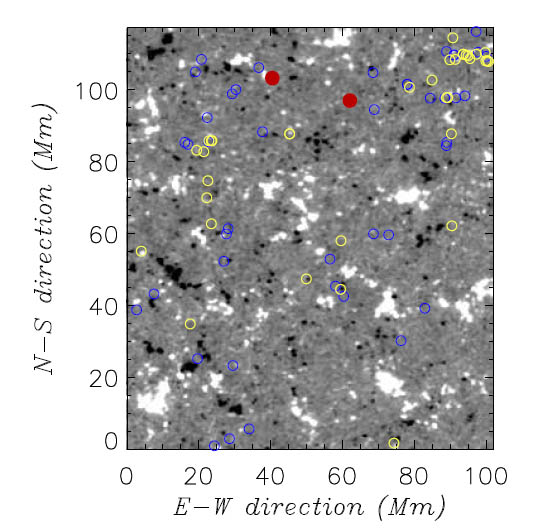|
|

|
Highlights
(Randomly generated highlights)
|
A new view of quiet-Sun topology from Hinode/SOT
S. Régnier, C. E. Parnell, A. L. Haynes
2008, A&A, 484, L47
|

|
|
Data Hinode/SOT-NFI
Method Potential field extrapolation; null point finding
Results The number of null points in the solar atmosphere: 54% in the
photosphere, 44% in the chromosphere and only 2% in the corona. This reveals the complexity
of the photospheric and chromospheric quiet-Sun magnetic fields.
|
|
|
|
Abstract
With the recent launch of the Hinode satellite our view of the nature and evolution of quiet-Sun
regions has been improved. In light of the new high resolution observations, we revisit the study
of the quiet Sun's topological nature. Topology is a tool to explain the complexity of the magnetic
field, the occurrence of reconnection processes, and the heating of the corona. This Letter aims
to give new insights to these different topics. Using a high-resolution Hinode/SOT observation
of the line-of-sight magnetic �eld on the photosphere, we calculate the three dimensional magnetic
field in the region above assuming a potential field. From the 3D field, we determine the existence
of null points in the magnetic configuration. From this model of a continuous field, we find that
the distribution of null points with height is significantly different from previous studies. In
particular, the null points are mainly located above the bottom boundary layer in the photosphere
(54%) and in the chromosphere (44%) with only a few null points in the corona (2%). The density of
null points (expressed as the ratio of the number of null points to the number of photospheric magnetic
fragments) in the solar atmosphere is estimated to be between 3% and 8% depending on the method used to
identify the number of magnetic fragments on the observed photosphere. This study reveals that the
heating of the corona by magnetic reconnection at coronal null points is unlikely. Our findings do
not rule out the heating of the corona at other topological features. We also reveal the topological
complexity of the chromosphere as strongly suggested by recent observations from Hinode/SOT.
|

|
|